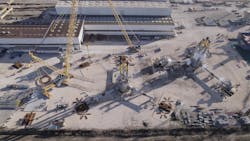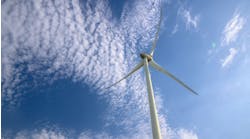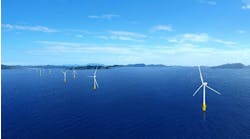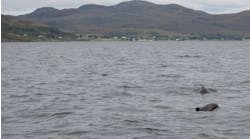A Staff Report
FRANCE IS EMBRACING OFFSHORE WIND, with the country’s first development due to start operating off the west coast later this year, and more fixed and floating wind farm projects emerging off its southern and northern shores. Eiffage Métal is providing components for three of the initial schemes, and plans upgrades in manufacturing capacity at its yard in southern France to support the expansion of deepwater wind power in the Mediterranean Sea.
“We are on time, and the entire project is on track to be delivered in June,” said Eiffage Métal’s Director Energy & Industry Arnaud De Villepin. “This has been an achievement for various reasons. It’s France’s first offshore wind farm, and fabrication started at the beginning of 2020, just when COVID was emerging. However, delivery times have not been affected: we did not close our factories and workshops, but through installing a system of barriers, we were able to manage the situation. And the most critical element of the project - the offshore installation method - has proven capable of dealing with the variable, occasionally rocky, seabed conditions.” DEME has deployed a specially developed subsea waves protection device that allows the foundations and monopiles to be driven or drilled, or both.
On France’s central south coast, Eiffage Métal’s yard in Fos-sur-Mer is responsible for fabrication of three floating structures for a pilot floating offshore wind project in the Mediterranean Sea in 70 m (230 ft) water depth, 17 km (10.6 mi) from Port Saint Louis du Rhône. EDF Renewables’ Provence Grand Large project is based on a proprietary TLP concept developed by SBM Offshore and IFP Energies Nouvelles for low motions and accelerations at nacelle level. The pilot will feature three Siemens 8-MW wind turbines. Eiffage Métal expects to complete assembly of the nodes, columns and transition pieces this summer: SBM has performed some of the pre-fabrication in China, with various other items being shipped from Turkey to Fos, which has direct access to the sea.
SBM will also manage the installation scope. The three completed triangle-shaped floaters, measuring 45 x 90 x 90 m (147 x 295 x 295 ft), will be loaded at the quayside via trailers onto a barge which will then head offshore to undergo ballasting until the structures are floating in the water. They will then be taken to another quay for installation of the turbines and towers into the central columns, followed by towing to another site 20 km (12.4 mi) from Fos for connection with electrical cables and the local grid.
Pre-fabrication was due to start this month for a second project in the Mediterranean, the 30-MW Leucate floating offshore wind farm, which will be located in 65-80 m (213-262 ft) of water 16 km (9.9 mi) from the Leucate-Le-Barcarès area, close to the border with Spain. The project’s developer is Les Eoliennes Flotantes du Golfe de Lion, a joint venture between Ocean Winds and Caisse de Depots. Eiffage Métal is the EPCI contractor for the floaters. Fos will assemble the three WindFloat structures, based on Principle Power Inc’s (PPI) semisubmersible concept, featuring bracings and measuring 75 x 75 x 25 m (246 x 246 x 82 ft). Each will support a Vestas V164 10-MW wind turbine. According to De Villepin, PPI has longer experience in floating offshore wind and its design is lighter. The floaters represent the third generation of PPI’s WindFloat technology, and incorporate innovations in modularization and manufacturability that were initiated based on recommendations by Eiffage Métal. The structures, with a design life of 20 years, should start supplying power to over 50,000 homes locally in 2023.
Eiffage Métal is also monitoring developments elsewhere in France. Last May, the EMD consortium and RTE, the French electricity grid operator committed to develop a 600-MW fixed offshore wind farm off Dunkerque in the far north of France following public consultations (the government had awarded the project in 2019). Tenders for the construction could be issued by 2023. Another prospective fixed offshore wind development in the north, and currently in the tender phase, is offshore the Cotentin Peninsula, Normandy, with a planned capacity of 1 GW. Off the northwest coast, 10 consortia have pre-qualified to tender for the 250-MW South Brittany floating offshore wind project, comprising up to 20 wind turbines off the coast of Groix and Belle-Île-en-Mer. Bids are due to be submitted by October. To support its future tenders, Eiffage Metal is considering investing in local fabrication/assembly at sites in Cherbourg and Brest
In the UK, Smulders and Sif will start fabrication next year of the 200 transition pieces and monopiles for the Dogger Bank C wind farm offshore England’s east coast. As with Dogger Bank A and B, where fabrication continues, these will be assembled, coated and tested at Smulders’ plant in Hoboken Belgium. Eiffage Métal is also investing in new facilities to enable its yard in Wallsend on the River Tyne, northeast England to talke on manufacture of transition pieces. One target is the next series of fixed and floating wind projects planned offshore Scotland following last year’s ScotWind leading process. Other prospects include TotalEnergies’ 100-MW Erebus floating offshore wind demonstrator in the Celtic Sea offshore Wales, and various wind farms planned offshore England, Ireland, Italy, Spain and Norway. In the US, Smulders recently secured a contract to provide secondary steel for the Soithfork and Revolution Offshore wind farms off Rhode Island, and is teaming up with Welcon to pursue further opportunities in the US sector.
Despite the abundance of opportunities, driven largely by the race to deliver net-zero emissions, the reality is that renewable energy projects are encountering bottlenecks and cost issues caused by recent global developments. The impact of last year’s extended blockage of the Suez Canal is still apparent, De Villepin said, with backlogs of vessels transporting components causing serious problems for the supply chain. The crisis in Ukraine and sanctions against Russia have also led to constraints in the availability of steel, and steep increases in steel prices.




